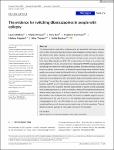The evidence for switching dibenzazepines in people with epilepsy
| dc.contributor.author | Watkins, L | |
| dc.contributor.author | O'Dwyer, M | |
| dc.contributor.author | Oak, K | |
| dc.contributor.author | Lawthom, C | |
| dc.contributor.author | Maguire, M | |
| dc.contributor.author | Thomas, R | |
| dc.contributor.author | Shankar, Rohit | |
| dc.date.accessioned | 2021-05-22T19:21:59Z | |
| dc.date.issued | 2020-08 | |
| dc.identifier.issn | 0001-6314 | |
| dc.identifier.issn | 1600-0404 | |
| dc.identifier.uri | http://hdl.handle.net/10026.1/17181 | |
| dc.description.abstract |
The dibenzazepines particularly carbamazepine are associated with known adverse effects (AEs) and drug to drug interactions. Eslicarbazepine acetate (ESL) is structurally distinct from other members of the dibenzazepine family and has the advantage of once daily dosing. Observational and trial data report successful switching from older dibenzazepines to ESL. The evidence base for doing so is unclear and not standardized. This is a literature review following the PRISMA scoping guidelines identifying the evidence of switching dibenzazepines. Transition methods, ratios, tolerance to change, adverse effects and retention post-change were evaluated. Study quality was assessed using the Oxford Centre for Evidence Based Medicine levels of evidence. Seven studies investigated the outcome of transition between carbamazepine and or oxcarbazepine to ESL, with specific data on the transition dose ratio and scheduling. The available data suggest that the overnight transition between oxcarbazepine and ESL in a 1:1 ratio (most common) is generally well tolerated with high retention rates. The transition showed improvement in adverse events associated with oxcarbazepine across a variety of domains. Almost 60% transitioned because of adverse events experienced no further symptoms at 12 months. There is less data on the transition from carbamazepine to ESL. The evidence available suggests an overnight transition in the ratio of 1:1.3-1.5. The retention rate following transition from carbamazepine to ESL was 69% (follow-up of 4 months) with almost half of those transitioned because of adverse events experiencing no further symptoms. There is Grade C evidence available to help guide clinicians in the transition. | |
| dc.format.extent | 121-130 | |
| dc.format.medium | Print-Electronic | |
| dc.language | en | |
| dc.language.iso | eng | |
| dc.publisher | Hindawi Limited | |
| dc.rights | Attribution-NonCommercial-NoDerivatives 4.0 International | |
| dc.rights | Attribution-NonCommercial-NoDerivatives 4.0 International | |
| dc.rights | Attribution-NonCommercial-NoDerivatives 4.0 International | |
| dc.rights | Attribution-NonCommercial-NoDerivatives 4.0 International | |
| dc.rights.uri | http://creativecommons.org/licenses/by-nc-nd/4.0/ | |
| dc.rights.uri | http://creativecommons.org/licenses/by-nc-nd/4.0/ | |
| dc.rights.uri | http://creativecommons.org/licenses/by-nc-nd/4.0/ | |
| dc.rights.uri | http://creativecommons.org/licenses/by-nc-nd/4.0/ | |
| dc.subject | efficacy | |
| dc.subject | epilepsy | |
| dc.subject | eslicarbazepine acetate | |
| dc.subject | safety | |
| dc.subject | switch | |
| dc.subject | tolerability | |
| dc.title | The evidence for switching dibenzazepines in people with epilepsy | |
| dc.type | journal-article | |
| dc.type | Journal Article | |
| dc.type | Review | |
| plymouth.author-url | https://www.webofscience.com/api/gateway?GWVersion=2&SrcApp=PARTNER_APP&SrcAuth=LinksAMR&KeyUT=WOS:000528732500001&DestLinkType=FullRecord&DestApp=ALL_WOS&UsrCustomerID=11bb513d99f797142bcfeffcc58ea008 | |
| plymouth.issue | 2 | |
| plymouth.volume | 142 | |
| plymouth.publication-status | Published | |
| plymouth.journal | Acta Neurologica Scandinavica | |
| dc.identifier.doi | 10.1111/ane.13248 | |
| plymouth.organisational-group | /Plymouth | |
| plymouth.organisational-group | /Plymouth/Faculty of Health | |
| plymouth.organisational-group | /Plymouth/Users by role | |
| dc.publisher.place | Denmark | |
| dcterms.dateAccepted | 2020-03-27 | |
| dc.rights.embargodate | 2024-01-03 | |
| dc.identifier.eissn | 1600-0404 | |
| rioxxterms.versionofrecord | 10.1111/ane.13248 | |
| rioxxterms.licenseref.uri | http://creativecommons.org/licenses/by-nc-nd/4.0/ | |
| rioxxterms.licenseref.startdate | 2020-08 | |
| rioxxterms.type | Journal Article/Review |



